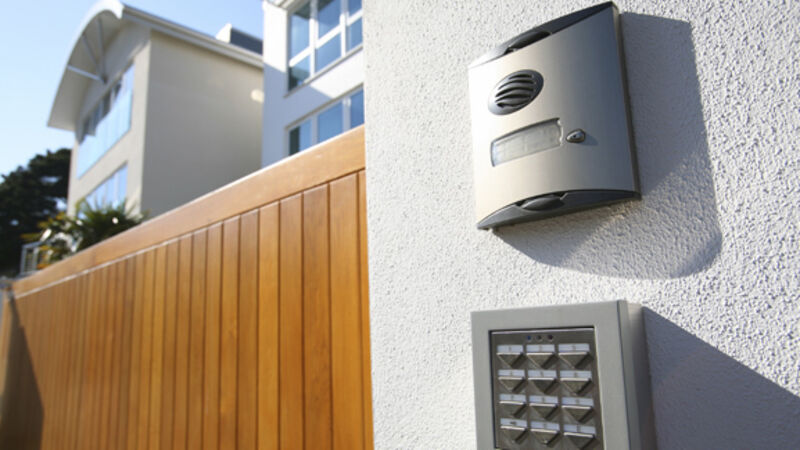Everything you need to know about access and security around the home

Automatic gates — an open and shut case? Not so very long ago the cool, silent swing of an electric (automated), gate was considered the province of Norma Desmond — a perk for Batman, even, on his return to the bat-cave?
I was convinced that the inclusion of such fabulous luxury and convenience, must come with a fabulous, luxuriant price. Further to that supposition, was the notion that having a gate simply signalled that the owners had something worth clambering over the gate for. Was it ostentatious? Drawing attention? Was there really any security advantage for a determined intruder?
Michael O’Connell, owner and MD at AES Security in Cork, agrees that yes, an electric gate might be read as there being something worth taking within, but emphasises that a closed, secured gate is a major deterrent to the opportunist thief:
“With the main gate locked, they cannot in most instances, get a large vehicle up to the property. This limits criminals to what they can physically carry. Generally, they will move on.”
The fact that a gate is closed, manual or automated regardless of its actual strength, sends a powerful message, and it has some legal muscle too. John McLaughlin, Marketing Director at AES, agrees that ramming, for instance, is a rare occurrence: “Gates greatly enhance the level of security of the home and property. If the gates are open, any person is legally entitled to enter, however if they are closed and locked they are, by law, trespassing.
“With a closed panel gate, they can’t see in, which is not appealing and it says, above all — go away.”
So, what are the advantages to having automatic gates? They close and lock. Most of us, even with manual gates worthy of Games of Thrones, cannot be bothered to clamber out in a light drizzle, close and secure our gates. Automatic gates can be timed to close after a short interval, if you don’t like the car being patted on the behind by a closing mechanism.
The cocker spaniel is break-dancing around the car, the two-year-old is thrashing herself out of the seat belt like Houdini over the Hudson – but you don’t have to worry about securing the gate before you alight.
Automatic gates don’t only secure the property, they also keep in pets and children at play around the outside of the house, presuming that is, you have them matched to high fencing. Taller oblique timber varieties of gate will obscure the view of anyone likely to watch your home, cars and family for whatever reason. Just about any gate can be retro-fitted with an automatic mechanism.
Gates are described as wing or leaf, the latter divided into separate moving parts. Your supplier will often work with a number of reputable gate fabricators to come up with the best combination of gate and articulation for your site.
John McLaughlin emphasises that matching gate design to the installation type is critical to the gate’s performance and safety.
The choice or automation will come down to the type of gate you are using (designed from new or when retro-fitting a mechanism); the position of the gate; the terrain; the incline and the gate’s weight — which influences the size of motor used.
Hydraulic systems are available, but the standard, cost-effective choice is an electro-mechanical gate which runs off a standard 220V domestic supply.
Hydraulic gates are extremely quiet and will hold a closed panel gate more firmly in a windy situation.
Sliding gates operate on a glide-track set into the ground and have a tidy finish. No gate is impenetrable, but a single piece sliding gate mounted on a track, that moves in a parallel motion back against the adjoining fence or wall is very secure and least likely to be rammed open.
If the house is reached by an uphill driveway, a sliding gate is the perfect answer, as the gate is not forced over a gradient or hanging in mid-air when opening outward.
In tight situations, with a twist to the drive, there’s no issue of getting around the gate during a manoeuvre. It’s important to ensure there is plenty of room for the gate to slide back against the perimeter. Sliding gates are operated by a single gear motor on a rack and pinion drive principle.
There are three types of swing mechanisms. The first two are what is termed over-ground operators with the motors and arms on show on the pillars and gates.
The cheapest and more visible option is the articulated arm, with a motor attached to the gate pillar or pillars and an ‘L’ shaped arm on the back of the gate that, using a motor shaft, pulls the gate open.
Linear over-ground electronic gates (also known as actuators or ram types), have a sleeker, appearance.A horizontal actuator spindle is attached to the gate wing and the driver mechanism to the pillar. The spindle extends to close and retracts to open the gate.
Underground mechanisms, take the motor completely out of sight and are set into the ground in a ‘ motor box’ and are popular for their flush, unobtrusive finish which does not vie with the aesthetics of a lovely gate.
It’s vital to ensure there are no drainage issues around the gateway which would allow water to fill the box position, shorting the electrics of the mechanism and disabling the gate.
The controls surrounding your gate can be as sophisticated as the contents of your wallet allow, but even standard packages offer versatile choices that will deliver gates that are safe, convenient, secure and familiar to the whole family.
Key ring transmitters which ping the gates open or closed from around 100m away are the most common form of control (at least 2 are given with a standard kit).
With a GSM controller added to the automation, you can also divert the operation of the gate through your mobile phone, allowing access by nominated phone users too.
A simple text command can keep your gates open for an assigned period and there’s the added advantage of text and email support from your supplier.
Audio-video intercoms allow visitors to press a button and be identified by voice or view, at a receiver up at the house. A key-pad on the control box means you can provide an access code to say, trades coming to work on the house, and then change the code for total peace of mind.
What about power outages, will I be trapped in my home? Michael O’Connell laughs:
“No, that’s not a problem. Every gate will have a manual operation, generally a straight forward hand crank for these situations.”
Buying a gate automation kit and having it fitted to a gate, starts in the area of €600 plus the installation cost. Obviously, you should only choose individuals with experience in the area of gate automation and a RECI qualified electrician.
Ask to see one of their recent installations in action. Any civic work, for example putting in underground automation and running conduits down a long driveway will increase this price as will tweaking safety issues that arise due to poor communication between the gate design team and the supplier of the gate mechanics.
The inclusion of CCTV will also push up the number. A package including a vehicular gate, an intercom and swing automation with quality aluminium components will come in the area of €2,000.
“If you are building a new house or renovating the driveway, install boxes for motored automation of the gate, even if you’re not having a powered gate right away,” says John McLaughlin of AES.
“Have your contractors run electrical cables to the wing positions too. This will cut down on the civic work needed in the future to allow for lighting, intercoms and more.
“Quite honestly, the presence of the boxes makes it appear your gate is already automated,” he concludes.
* With many thanks to the team at AES (Alarm Equipment Supplies Ltd.), Kinsale Road Commercial Centre. www.aesireland.ie 021-4964777.
Dogs have keener sight and hearing than humans and generally have the instinct to protect their home territory and yours, alerting you to unusual activity, sounds and the arrival of anyone to the property.
This does not mean that your dog is a ‘guard dog’ — a trained animal used for non-residential situations. Having a trained commercial guard dog at home may leave you open to litigation if it attacks and injures any visitor.
Smaller dogs make superb alarms, but obviously don’t have the physique or inherent potential threat of larger dogs. Even a larger dog without specialist training can prove an obliging lump. Stories abound of elephant-sized dogs letting intruders in without sounding a feeble ‘woof’.
However, there are also what is termed ‘protection dogs’ offered by specialist companies such as K9 Security, who are trained to protect their owners above all. These are carefully chosen animals, generally German Shepherds, trained from a few weeks old and capable of defending their family with instant recall when required.
They are pets, chosen to fit in with the family, including being gentle around children and other companion animals. They are not supposed to be aggressive or reactive, but I would add that no animal is a machine.
A dog likely to protect you, your family and your property effectively will have a steady, confident personality — it won’t be a raging lunatic exploding each time the shivering postman drops the mail and flees.
Andrew Hayes of K9 Security explains:
“We have clients with specific needs — professional couples, people with fears surrounding home invasion and ordinary families.
“The dogs are conditioned from an early age, and receive on-going training after placement at 1-1½ years old. The family also receives training, and we’ll decide where the dog will sleep, for example on the landing outside the bedrooms.”
Expect to pay in the area of €2,500 for a healthy adult dog trained to this level with a guarantee of a good personality and behaviour.
* www.K9securityireland.com
Automatic gates are a powered machine, and in the wake of several known fatalities in recent years, last week the UK industry held a Gate Safety Week, underlining the need for proper gate maintenance. Here are the key points to bring up with your supplier to ensure safe operation of all automatic gates used at home.
* Your new powered gate should come with a “Declaration of Conformity” and be CE marked
* Automatic gates should be protected by “touch sensitive” control, (either by rubber safety edges or intelligent drive units), that will cause the gate to retract if it encounters an obstacle
* There should also be “light beams” across the entrance as a backup measure. Light beams should never be the sole protection measure – unless they form multi-beam curtaining that prevents all possible access to the moving gate
* The hinge area should be protected by flexible guards or rubber safety edges, or have “constant gap” hinges
* Getting a foot trapped under the gate should be prevented by either- rubber safety edges or a 120mm safety clearance, or be flush with the ground such that a child’s foot cannot fit under the gate
* Where a gate creates a shearing hazard as it passes a fixed support element, wall or fence (very common with a sliding gate), there should be rubber safety edges or fencing to prevent access to the dangerous movement.
* Always make a visual survey before operating your gate
* Photo beams detect vehicles and people and will not allow the gates to be operated until the area is clear, alternatively an underground loop detector will just detect vehicles.












